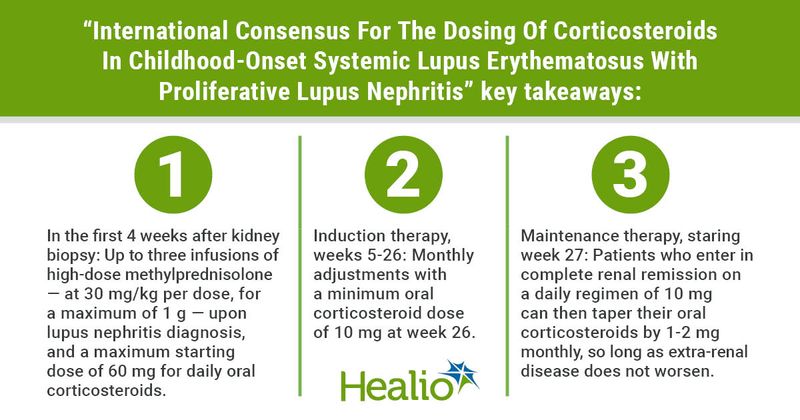CARRA, PReS issue guidance for corticosteroid dosing in childhood-onset lupus nephritis
Patients with childhood-onset lupus nephritis should receive up to three infusions of methylprednisolone at 30 mg/kg per dose upon diagnosis, with a maximum 60 mg of daily oral corticosteroids in the first 4 weeks, according to researchers.
That recommendation comes from a new international consensus developed by a group of researchers in partnership with the Childhood Arthritis Rheumatology Research Alliance (CARRA) and the Pediatric Rheumatology European Society (PReS). Published in Arthritis & Rheumatology, the standardized steroid dosing regimen covers the first 4 weeks post-kidney biopsy through induction and maintenance therapy.

“Corticosteroids (CS) remain one of the mainstays of therapy in childhood-onset systemic lupus erythematosus (cSLE), especially with major organ involvement such as lupus nephritis (LN),” Nathalie E. Chalhoub, MD, MSc, of the University of Cincinnati College of Medicine, and colleagues wrote. “Due to lack of strong medical evidence, dosing of CS for cSLE treatment remains mainly provider dependent.”
“Delphi surveys and expert opinion were previously employed to propose standards for CS use, including for proliferative LN in children as part of the Consensus Treatment Plans for pediatric LN (CTPLN),” they added. “However, when tested in real life settings, providers followed the CS dosing recommended by the CTPLN in only 68% of patients by 3 months, and just 37% of patients by 6 months of induction therapy for LN.”
To develop a standardized dosing regimen for corticosteroids in patients with childhood-onset SLE and proliferative lupus nephritis, Chalhoub and colleagues used a consensus formation methodology. First, a literature review of studies on children with proliferative lupus nephritis, combined with a Delphi questionnaire sent to the CARRA Lupus Nephritis Work Group and a consensus meeting of all group members, helped generate patient profiles. Physicians then rated change in activity of renal and extra-renal juvenile-onset SLE between two consecutive visits, and later proposed corticosteroid dosing.
Using a total of 5,056 patient profile ratings, the researchers crafted the steroid regimen, with edits and refinements made during a physician focus group. A second type of profile, describing childhood-onset SLE course through at least 4 months following kidney biopsy, was used to validate recommended oral and intravenous doses. In all, validation for up to 6 months post kidney biopsy was achieved with 1,838 patient profile ratings. Profile adjudication was based on majority ratings for renal and extra-renal disease course. A consensus of 80% was required to approve each aspect of the regimen.
The final consensus regimen allows for up to three infusions of high-dose methylprednisolone — at 30 mg/kg per dose, for a maximum of 1 g — upon lupus nephritis diagnosis, and a maximum starting dose of 60 mg for daily oral corticosteroids. In addition, depending on extra-renal disease activity and treatment response, oral corticosteroids may be decreased weekly to a minimum dosage of 40 mg at week 4.
From there, the consensus recommends monthly adjustments during induction therapy — weeks 5 to 26 — with a minimum oral corticosteroid dose of 10 mg at week 26. The consensus provides examples and suggested dose adjustments for patients who demonstrate major worsening of extra-renal disease activity despite improving renal disease in the first 12 weeks following kidney biopsy. Determination of partial and complete renal remission can occur at the end of week 26.
“Chronic, especially high-dose use of CS is a major risk factor for infections, a leading cause of death in SLE,” Chalhoub and colleagues wrote. “Due to their CS-sparing properties, concurrent use of immunosuppressive medications is recommended during induction therapy for LN, and was considered in the development of the [standardized steroid regimen].”
Patients who enter maintenance therapy — starting at week 27 — in complete renal remission on a daily regimen of 10 mg can then taper their oral corticosteroids by 1 mg to 2 mg monthly, so long as extra-renal disease does not worsen. Meanwhile, non-responders should follow a dosage chosen based on repeat biopsy findings.
“In clinical trials, variability of CS dosing introduces bias and threatens the validity of study results,” Chalhoub and colleagues wrote. “By standardizing CS use, the SSR can counterbalance such bias, and possibly increase the willingness of physicians to contribute patients to studies. The SSR may also support CS use in clinical care, especially by health care providers with less exposure to the treatment of cSLE and pediatric LN. We would like to note that, to enhance the widespread use of the SSR, a web-based calculator is in development.”
